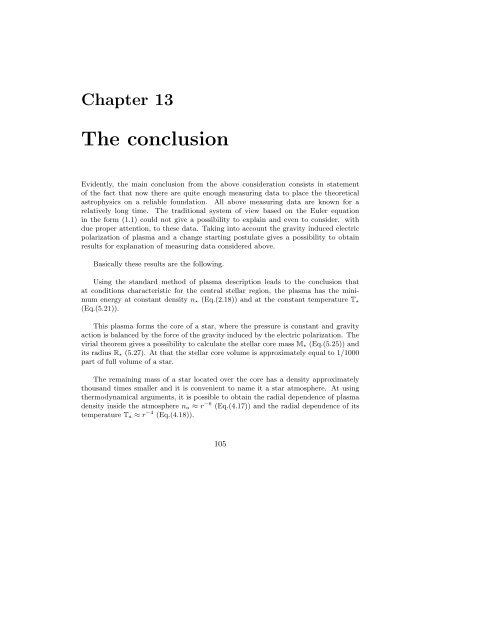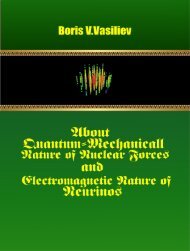VbvAstE-001
Book Boris V. Vasiliev Astrophysics
Book Boris V. Vasiliev
Astrophysics
Create successful ePaper yourself
Turn your PDF publications into a flip-book with our unique Google optimized e-Paper software.
Chapter 13<br />
The conclusion<br />
Evidently, the main conclusion from the above consideration consists in statement<br />
of the fact that now there are quite enough measuring data to place the theoretical<br />
astrophysics on a reliable foundation. All above measuring data are known for a<br />
relatively long time. The traditional system of view based on the Euler equation<br />
in the form (1.1) could not give a possibility to explain and even to consider. with<br />
due proper attention, to these data. Taking into account the gravity induced electric<br />
polarization of plasma and a change starting postulate gives a possibility to obtain<br />
results for explanation of measuring data considered above.<br />
Basically these results are the following.<br />
Using the standard method of plasma description leads to the conclusion that<br />
at conditions characteristic for the central stellar region, the plasma has the minimum<br />
energy at constant density n ⋆ (Eq.(2.18)) and at the constant temperature T ⋆<br />
(Eq.(5.21)).<br />
This plasma forms the core of a star, where the pressure is constant and gravity<br />
action is balanced by the force of the gravity induced by the electric polarization. The<br />
virial theorem gives a possibility to calculate the stellar core mass M ⋆ (Eq.(5.25)) and<br />
its radius R ⋆ (5.27). At that the stellar core volume is approximately equal to 1/1000<br />
part of full volume of a star.<br />
The remaining mass of a star located over the core has a density approximately<br />
thousand times smaller and it is convenient to name it a star atmosphere. At using<br />
thermodynamical arguments, it is possible to obtain the radial dependence of plasma<br />
density inside the atmosphere n a ≈ r −6 (Eq.(4.17)) and the radial dependence of its<br />
temperature T a ≈ r −4 (Eq.(4.18)).<br />
105













